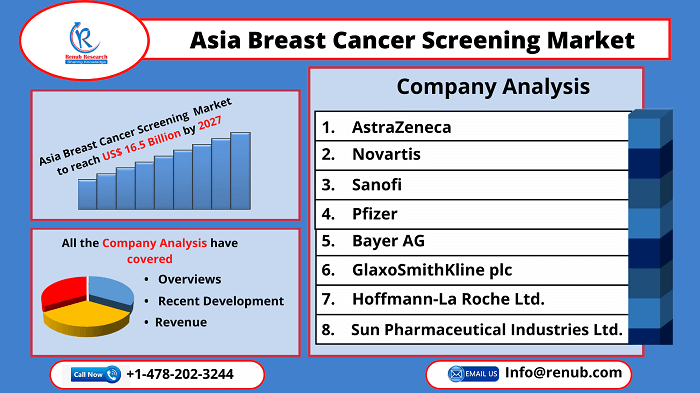Asia Breast Cancer Screening Market to reach USD 16.5 Billion by 2027, due to increasing breast cancer awareness, government and NGOs supporting programs, and the aging population
24 Nov, 2022
According to Renub Research latest report titled "Asia Breast Cancer Screening Market, Size, Forecast 2022-2027, Share, Industry Trends, Growth, Impact of COVID-19, Opportunity Company Analysis," Asia Breast Cancer Screening Market, Size will grow to US$ 16.5 Billion by 2027. Asia-Pacific, breast cancer is the most common type of cancer, specifically among females. As per Novotech, the Asia-Pacific CRO, breast cancer impacts 2.1 million patients every year. It is seen in advanced stages and among younger age group women in Asia.

Breast cancer can affect different breast parts like lobes and ducts. Thus, breast cancer screening is done to detect cancer earlier and secure that patients receive immediate treatment. Routine breast screening is necessary to prevent malignancy. Breast cancer screening is a regular test to detect breast cancer. Early detection could provide patients with timely treatment, decreasing the mortality rate. Breast cancer screening commonly involves mammography, scan, MRIs, or ultrasound. Mammography is considered a multiple helpful screening tests for the detection of breast cancer.
Besides, China, Japan, India, Singapore, Thailand, and Korea are the top contributors. Raising breast cancer awareness, government and NGOs funding breast cancer screening programs, and the aging female population is significant driving forces for the Asia breast cancer screening market. In addition, technological advancement is an important trend in the breast cancer diagnostics market. Several novel approaches have been developed that could be useful in detecting and treating breast cancer. For instance, breast tomosynthesis, or 3D mammography, captures photos of the breast from various angles and converts them into a 3-D model.
Mammography screening is the most substantial market in Asian Countries:
Based on methods, a mammogram is a leading method for breast cancer screening in Asian countries like India, Korea, Singapore, Thailand, China, Japan, and Malaysia. Japan, China, and Korea are the top three countries for breast cancer mammogram screening. Mammography is sophisticated medical imaging that utilizes a low-dose x-ray device to view human breasts indoors. Mammography plays a crucial role in Asia Pacific countries in treating women with breast disorders early.
Other modalities, such as ultrasound and (MRI) contrast-enhanced magnetic resonance imaging, play an essential role in breast cancer diagnostics, staging, and follow-up. Breast Magnetic Resonance Imaging (MRI) or breast ultrasound also helps detect breast cancer in women.
Breast Cancer Screening Market in China:
China's demand for breast cancer screening has grown fast in the past decade. Breast cancer is one of the most significant healthcare commitments in China. The Chinese economy holds a high pace of growth stimulated by the consecutive boost in capital investment. Further, China is the clear winner in the Asia breast cancer screening industry. It controls nearly three-fourths of the total screening market due to its extensive women population. Nevertheless, Government partial screening programs, poor awareness about breast cancer screening, and Global and domestic NGOs initiatives are helping China become a leader in the Asian breast cancer screening market.
COVID-19 Impact on the Asia-Pacific Breast Cancer Screening Market:
The COVID-19 pandemic has substantially affected hospital resources around the Asia-Pacific. COVID-19 has primarily been accomplished by drastically reducing inpatient and outpatient services for various disorders and instituting infection prevention and control methods. The number of cancer screening tests has declined dramatically, with the pandemic affecting countries all over the Asia-Pacific. The COVID-19 pandemic affects mortality and morbidity, and disruptions are predicted to last some time, challenging urgent cancer-related services. Early detection of breast cancer is necessary for expanded survival and long-term quality of life. Nevertheless, health services have been stressed in general, and efforts to discover and treat breast cancers early have been delayed in many settings with population breast mammography screening.
Key Companies & Market Share Insights:
Key players in the Asia-Pacific breast cancer screening tests market are GlaxoSmithKline plc, Hoffmann-La Roche Ltd., AstraZeneca, Novartis, Sanofi, Pfizer, Bayer AG, and Sun Pharmaceutical Industries Ltd.
Market Summary:
- Methods - Asia Breast Cancer Screening Market Analysis has been covered from 3 viewpoints (Mammography Screening Market, MRI Screening Market, Ultrasound Screening Market)
- Countries - This Report covered by countries7 viewpoints (India, China, Japan, Korea, Singapore, Thailand and Malaysia)
- All the major players have been covered from 3 Viewpoints (Overview, Recent Development, and Revenue Analysis) GlaxoSmithKline plc, Hoffmann-La Roche Ltd., AstraZeneca, Novartis, Sanofi, Pfizer, Bayer AG, and Sun Pharmaceutical Industries Ltd.
Reach out to us
Call us on
USA: +1-678-302-0700
INDIA: +91-120-421-9822
Drop us an email at
info@renub.com